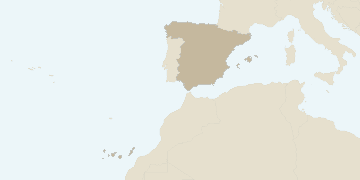Crimean-Congo haemorrhagic fever cases in Spain
CCHF cases reported in Leon (el Bierzo), north-western Spain

Ticks infected with Crimean-Congo haemorrhagic fever (CCHF) virus were first identified in western Spain in 2010 [1]. Since 2013, there have been 12 confirmed human cases of CCHF, including 4 deaths in Spain (see Table 1) [2]. The most recent confirmed cases (July 2022) were reported from el Bierzo, León province in the north-west of the country [2].
Table 1: Human cases of CCHF in Spain 2013 to 5 August 2022 [2]
| Region | Area | Number of cases | Year |
Castilla y-León |
Ávila province |
1 | 2013 |
| 1 | 2016 | ||
Salamanca province |
1 | 2018 | |
| 3 | 2020 | ||
| 1 | 2021 | ||
León province |
1 | 2021 | |
| 2 | 2022 | ||
| Extremadura | Badajoz province | 1 | 2018 |
| Madrid (hospital acquired case in healthcare worker) |
1 | 2016 |
Ticks infected with the virus have also been identified in the Spanish regions of Andalusia, Castilla y León, Castilla-La Mancha, Extremadura, and Madrid [3]. The Spanish Ministry of Health also report that the virus has recently been detected in animal serology (blood sample) studies carried out in Galicia and Catalonia regions [2].
CCHF is caused by a tick-borne virus. This virus has the widest geographic range of all tick-borne viruses and is endemic throughout Africa, the Balkans, the Middle East, western and south-central Asia, and Eastern Europe. Hyalomma ticks are the main reservoir and vector of CCHF virus [4-7].
The virus can be transmitted to humans by the bite of an infected Hyalomma tick, or through direct contact with blood, tissues, or body fluids of infected animals. Most cases occur in people living in tick-infested areas with occupational exposure to livestock including farmers, slaughterhouse staff and vets. Exposure to the virus may also occur from contamination with tick body contents/blood, for example, if a tick is squashed between the fingers [6].
Human-to-human transmission has been reported, as a result of exposure to blood, secretions, or other bodily fluids of infected persons [6, 8]. Cases have been reported in health workers caring for infected people [6]. Outdoor activities in endemic areas are a risk factor for tick exposure [7].
The incubation period (time from exposure to infection to symptoms appearing) depends on the mode of acquiring the virus. Following a tick bite, the incubation period is usually one to three days, with a maximum of nine days and the incubation period following contact with infected blood or tissues is usually five to six days, with a documented maximum of 13 days [4, 6].
Most people infected with the virus have no symptoms or experience a mild illness [7]. Early symptoms can include fever, muscle ache, dizziness, neck pain and stiffness, backache, headache, sore eyes, and photophobia (light sensitivity). There may be nausea, vomiting, diarrhoea, abdominal pain, and sore throat, followed by sharp mood swings and confusion. After two to four days, agitation may be replaced by sleepiness, depression, and lethargy [4, 6].
Other clinical signs include a fast heart rate (tachycardia), enlarged lymph nodes (lymphadenopathy) and a petechial rash (small, red, flat spots of blood) can develop in the mouth and throat, and on the skin. Larger rashes, called ecchymoses, and other signs of internal bleeding may appear. Rapid kidney, liver and/or pulmonary (lung) failure can occur after the fifth day of illness. Approximately 30 percent of diagnosed CCHF cases are fatal [6].
CCHF is not present in the United Kingdom (UK), nor are there any identified established populations of Hyalomma ticks, the vectors of CCHF virus. There is no licensed human CCHF vaccine available in the UK [7].
Advice for travellers
The risk of contracting CCHF for travellers in endemic areas is mainly related to tick bite exposure during outdoor activities. For most UK travellers visiting Spain, the risk is very low if precautions are followed. You can reduce your risk of infection with the following measures [6]:
- Avoid areas where ticks are abundant at seasons when they are most active (Spring to late Autumn).
- Use tick repellents and wear long sleeved clothing / socks.
- Check clothes and skin carefully for ticks and remove them with a recommended technique - see our insect and tick bite avoidance factsheet for details.
- If working with animals in endemic areas, use tick repellents on skin and clothing, and wear gloves/protective clothing to prevent skin coming into contact with infected tissues/blood [6].
Seek advice from your GP or NHS111 if you think you, or anyone in your family has symptoms and may have been exposed to CCHF. Remember - tell your healthcare provider that you travelled abroad.
Advice for health professionals
Health professionals should remain alert for travellers returning from CCHF affected areas who develop symptoms compatible with CCHF.
Health professionals should practise strict infection control precautions, including barrier nursing, when caring for patients presenting with haemorrhagic fever syndrome, including when there is suspicion of CCHF [7].
Guidance on the management of viral haemorrhagic fevers and similar human infections of high consequence is available from the Advisory Committee on Dangerous Pathogens (ACDP) [8].
There are specialised laboratory facilities in the UK to provide a definitive CCHF diagnosis. After discussion with their local microbiology, virology, or infectious disease consultant, health professionals can contact the Imported Fever Service (IFS) for advice and to arrange testing if indicated.
Health professionals seeking information about testing samples from patients with a possible viral haemorrhagic fever should read Viral haemorrhagic fever: sample testing advice before contacting the IFS.
Resources
References
-
General Directorate of Public Health of the Junta de Castilla y León. La Junta La Junta recibe la confirmación de un caso de fiebre hemorrágica Crimea Congo en Salamanca. 13 August 2020. [Accessed 30 August 2022]
-
Ministry of Health Spain, Detección de casos de Fiebre hemorrágica de Crimea-Congo en el Bierzo (León). 5 August 2022, [Accessed 30 August 2022]
-
Sánchez-Seco MP, Sierra MJ, Estrada-Peña A, et al, Widespread Detection of Multiple Strains of Crimean-Congo Hemorrhagic Fever Virus in Ticks, Spain. Emerg Infect Dis. 2022 Feb;28(2):394-402 [Accessed 30 August 2022]
-
World Health Organization. Crimean-Congo haemorrhagic fever. 2020. [Accessed 30 August 2022]
-
European Centres for Disease Control and Prevention. Crimean-Congo haemorrhagic fever (CCHF) – Annual Epidemiological Report for 2018. 18 December 2019. [Accessed 30 August 2022]
-
UK Health Security Agency, Crimean-Congo haemorrhagic fever: origins, reservoirs, transmission and guidelines. Last updated 27 March 2022. [Accessed 30 August 2022]
-
European Centre for Disease Prevention and Control. Factsheet about Crimean-Congo haemorrhagic fever. 2020. [Accessed 30 August 2022]
-
Department of Health and Social Care/Public Health England. Advisory Committee on Dangerous Pathogens (ACDP). Viral haemorrhagic fever: ACDP algorithm and guidance on management of patients. Last updated 19 November 2015. [Accessed 30 August 2022]
Explore more
Middle East respiratory syndrome coronavirus (MERS-CoV) reminder
NaTHNaC has reviewed MERS-CoV advice for UK travellers in line with current UK Health Security Agency recommendations and is reminding travellers to b
Updated: 05 September 2024Updated cholera 'green book' chapter published
The cholera chapter in the 'green book' (Immunisation against infectious disease) has been updated
Updated: 30 August 2024Crimean-Congo haemorrhagic fever in Spain
Advice for travellers following confirmed cases of CCHF in Spain
Updated: 28 August 2024Worldwide rabies risk reminder
A reminder for travellers of the global risk of rabies
Updated: 25 July 2024Changes to the Country Information pages: Hepatitis B
NaTHNaC has reviewed and updated country-specific Hepatitis B information and vaccine recommendations
Updated: 02 August 2024



